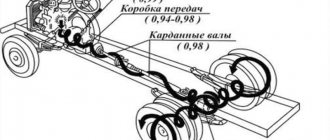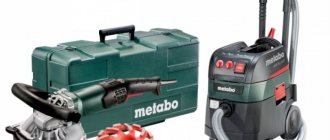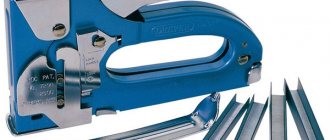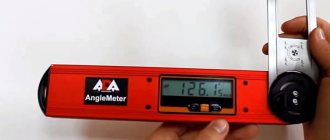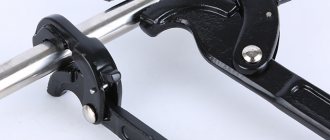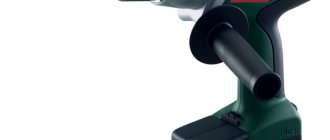to order Sooner or later, every user is faced with the need to use a special tool for unscrewing or screwing bolts or nuts. A wrench helps solve many technical problems. But such a tool is presented in a wide variety, taking into account the sizes.
Every man has one of these keys in his toolbox. The size of each is indicated on the handle, making selection easy. The numbers 7x8 mm show the distance from one rounded end to the other, the required turnkey thread diameter.
“ S ” - designation of a turnkey working surface. But there are simply no indicators on the bolts themselves. Experienced mechanics know how to determine the size of a nut, and despite this, they do everything by eye, because they visually determine the necessary tool. There are fasteners in places where you just can’t find them, so it will take a long time to select a wrench, taking into account the ratio of the thread diameter and the wrench size. If you do not guess the size, it will be difficult to unscrew the nut.
Preface
- 1 PREPARED by the Open Joint Stock Company "VNIIINSTRUMENT" (JSC "VNIIINSTRUMENT") on the basis of its own authentic translation into Russian of the international standard specified in paragraph 4
- 2 INTRODUCED by the Technical Committee for Standardization TC 95 “Tool”
- 3 APPROVED AND ENTERED INTO EFFECT by Order of the Federal Agency for Technical Regulation and Metrology dated May 20, 2013 No. 111-st
- 4 This standard is identical to the international standard ISO 3318:2009 “Fastening tools for screws and nuts. Double-sided open-end wrenches, double-ended socket wrenches and combination wrenches. Maximum external dimensions of heads" (ISO 3318:2009 "Assembly tools for screws and nuts - Double-headed open-ended wrenches, double-headed box wrenches and combination wrenches - Maximum widths of heads").
The name of this standard has been changed relative to the name of the specified international standard to bring it into compliance with GOST R 1.5-2004 (clause 3.5).
When applying this standard, it is recommended to use, instead of reference international standards, the interstate standard corresponding to them, acting as a national standard of the Russian Federation, information about which is given in the additional appendix DA
- 5 INTRODUCED FOR THE FIRST TIME
The rules for applying this standard are established in GOST R 1.0—2012 (section 8). Information about changes to this standard is published in the annual (as of January 1 of the current year) information index “National Standards”, and the official text of changes and amendments is published in the monthly information index “National Standards”. In case of revision (replacement) or cancellation of this standard, the corresponding notice will be published in the next issue of the information index “National Standards”. The corresponding information, notification and texts are also posted in the public information system - on the official website of the Federal Agency for Technical Regulation and Metrology on the Internet ()
© Standardinform, 2014
This standard cannot be fully or partially reproduced, replicated or distributed as an official publication without permission from the Federal Agency for Technical Regulation and Metrology
Selection of inch wrenches
The size of an inch wrench is expressed in inches and does not indicate the width of the wrench, but the diameter of the thread of the inch fastener it is designed to work with. The hexagonal working profile of inch bolts and nuts differs in size from the metric standard profile by fractions of millimeters. Therefore, metric wrenches will either not fit tightly onto the edges of inch fasteners, or will not fit at all. To work with it you need inch keys and socket heads.
Table 2. UNC/UNF Threads and Wrench Nut Sizes.
| Thread diameter (key size), inch | Wrench nut size, inch | Wrench nut size, mm |
| 1/4 | 7/16 | 11.11 |
| 5/16 | 1/2 | 12.7 |
| 3/8 | 9/16 | 14.29 |
| 7/16 | 5/8 | 15.88 |
| 1/2 | 3/4 | 19.05 |
| 9/16 | 13/16 | 20.63 |
| 5/8 | 15/16 | 23.81 |
| 3/4 | 1 1/8 | 28.58 |
| 7/8 | 1 5/16 | 33.34 |
| 1 | 1 1/2 | 38.10 |
| 1 1/8 | 1 11/16 | 42.86 |
| 1 1/4 | 1 7/8 | 47.63 |
| 1 3/8 | 2 1/16 | 52.39 |
| 1 1/2 | 2 1/4 | 53.15 |
| 1 3/4 | 2 5/8 | 66.68 |
| 2 | 3 | 76.20 |
| 2 1/4 | 3 3/8 | 85.73 |
| 2 1/2 | 3 3/4 | 95.25 |
| 2 3/4 | 4 1/8 | 104.76 |
| 3 | 4 1/2 | 114.30 |
How to use it correctly?
On the one hand, there is nothing complicated in using wrenches, yet it is a very simple tool, on the other hand, if you have no experience at all, then you need to know some things. Otherwise, there may be negative consequences, both for the key itself and for the nut.
First, and most importantly, the wrench must strictly match the size of the nut or bolt. The jaws should “sit” tightly on the part and only after that you can start working. Otherwise, there is a high risk of the wrench breaking off and damaging the part. Secondly, the movements should be smooth, pulling, and not sharp like jerks. This is primarily due to your safety: if the key falls off, then with sudden movements the chance of injuring your hand by hitting something increases sharply.
Everyone knows the life hack when the key is extended using a tube, which makes the lever arm longer and transmits more force. But in fact this is a mistake, since there is a risk of damaging the nut or the key itself. You need to understand that if you don’t have enough strength to tighten the nut, most likely you need to work with the nut itself (for example, lubricate it), and not try to apply inadequate efforts. Also, do not use wrenches that are damaged. This is dangerous.
Methods for determining key diameter
Universal tools are designed in such a way that there is no need to select the right wrench size. Their working units independently adjust to the diameter of the nut. But there are copies on sale, the range of settings of which is not suitable for working with the diameter of the existing fasteners. In this case, it is worth knowing how to determine and select the size. There are two effective methods.
Read also: ✅ How is the chainsaw bar length measured?
According to the thread diameter of the part
For a hex nut, a tool should be taken with a diameter that corresponds to the distance between the parallel edges of the nut itself. In order not to use a caliper or ruler in measurements, this value can be calculated from the diameter of the fastener thread. Such data is contained in the technical documentation, which is attached to the bolts and nuts by the manufacturer.
For standard thread diameters, two head sizes are given - reduced and normal. The first option is rare. The size chart for wrench tools is presented below:
- wrench 7 – bolt 4 mm;
- by 8 – 5 mm;
- turnkey bolt 10 has a thread diameter of 6 mm;
- 8 mm – tool No. 13;
- 10 mm – at 17;
- 12 mm – at 19;
- 14 mm - by 22.
And so on.
Determining the turnkey size by the diameter of the bolt head
The second method is no less informative, but you need to use additional tools. As already mentioned, the size of the wrench corresponds to the distance between the two parallel edges of the nut. If there is no information about this value, then you should take a millimeter ruler, or better yet a caliper, and measure this distance. When using a straight edge, remember that it must be applied exactly through the center point of the bolt head. It is not always possible to do this correctly, so the most reliable result will be given by a caliper. The turnkey bolt size will correspond to the tool number.
Types and purpose
The most common types of universal wrenches for bolts and nuts are the socket wrench and the self-locking wrench.
The self-locking tool differs in its operating principle. Its main component is a ratchet mechanism with quick adjustment. The person working with this wrench can immediately adjust the size of the tool to the head of the bolt or nut. The self-adjusting design eliminates the need for the technician to constantly remove the key from the fasteners while tightening or unscrewing.
The unique convex design of the jaws ensures the integrity of the nut is maintained. The wide range of size adjustment eliminates the need for other wrenches, since most of the installation and dismantling of metal structures held together with bolts or nuts can be performed with the help of a universal self-adjusting tool.
Thanks to the ratcheting mechanism, the load on the master’s hand is reduced, the working time is reduced, and the handle returns to its original position in a matter of seconds.
The universal end tool is significantly different from the previous one. The design is complemented by a head with a universal socket, which, upon contact with the fastener, immediately takes its shape. It is suitable for working with hex bolts, nuts, screws, hooks and other types of fasteners.
The main advantage of a socket wrench is its large adjustment range. The socket head easily handles parts whose size varies from 7 to 19 mm. That is, with just one such tool you can assemble and disassemble a variety of structures.
Face and self-locking tools allow the master to quickly complete the required amount of work. They are a good alternative to conventional double-end open-end wrenches.
How to determine the turnkey size of a bolt and nut?
Any person, even not associated with mechanics, has to unscrew and tighten bolts and nuts in everyday life. To do this, we most often use a wrench, of which there are about fifteen varieties today. The classic and most common tool is the double-sided open-end wrench, which can be found in every man’s toolbox. The dimensions of its working profiles are marked on its handle, for example: 7x8 or 17x19, etc. These numbers indicate the distance from one sponge to another in millimeters.
Adjustable wrenches and their advantages
An adjustable wrench is a tool that looks like an open-end wrench with a variable distance between the jaws. The main advantage of this tool is its versatility in size. Due to their versatility, such tools are used mainly in everyday life.
Professionals use such tools extremely rarely, which is due to a number of inherent disadvantages:
- The presence of play in the movable jaw makes it impossible to squeeze the nut to unscrew or screw it in
- Over time, the moving jaw mechanism wears out, causing even more play to occur.
- Low strength, due to which it is impossible to exert great effort to unscrew
- The need for constant adjustment of the position of the movable jaw
You can use this wrench when you need to unscrew loosely tightened nuts or bolts. In all other cases, this device is characterized by low efficiency and reliability.
Determining the key number by the diameter of the fastener thread
The “wrench” size of a hex bolt or nut is the distance between two parallel faces. You can quickly and accurately find out it, without resorting to a ruler or caliper, by the diameter of the threaded part, which is indicated in the technical information for the fastener. The fact is that each standard thread diameter corresponds to a certain size of the working profile of the fastener - main (normal), reduced and enlarged. Bolts with reduced and increased head sizes are much less common.
Using the table, you can easily determine which wrench size is suitable for a particular bolt from M1 to M110.
Table 1. Wrench sizes for metric bolts and nuts.
| Thread diameter, M | Key size | ||
| main S , mm | reduced S , mm | increased S , mm | |
| M1 | 3.2 | — | — |
| M1.2 | 3.2 | — | — |
| M1.4 | 3.2 | — | — |
| M1.6 | 3.2 | — | — |
| M2 | 4 | — | — |
| M2.5 | 5 | — | — |
| M3 | 5.5 | — | — |
| M4 | 7 | — | — |
| M5 | 8 | — | — |
| M6 | 10 | — | — |
| M7 | 11 | — | — |
| M8 | 13 | 12 | — |
| M10 | 17 (16) | 14 | — |
| M12 | 19 (18) | 17 | 21 (22) |
| M14 | 22 (21) | 19 | 24 |
| M16 | 24 | 22 | 27 |
| M18 | 27 | 24 | 30 |
| M20 | 30 | 27 | 32 (34) |
| M22 | 32 (34) | 30 | 36 |
| M24 | 36 | 32 | 41 |
| M27 | 41 | 36 | 46 |
| M30 | 46 | 41 | 50 |
| M33 | 50 | — | 55 |
| M36 | 55 | 50 | 60 |
| M39 | 60 | 55 | 65 |
| M42 | 65 | 60 | 70 |
| M48 | 75 | — | 75 |
| M52 | 80 | — | 80 |
| M56 | 85 | — | — |
| M60 | 90 | — | — |
| M64 | 95 | — | — |
| M68 | 100 | — | — |
| M72 | 105 | — | — |
| M76 | 110 | — | — |
| M80 | 115 | — | — |
| M85 | 120 | — | — |
| M90 | 130 | — | — |
| M95 | 135 | — | — |
| M100 | 145 | — | — |
| M105 | 150 | — | — |
| M110 | 155 | — | — |
Some modern ISO standards specify other hex head sizes; they are listed in parentheses in the table.
The dimensions of the wrench mouth are defined in the GOST 6424-73 standard. With proper selection, the gap between the working jaws of the tool and the edges of the fastener does not exceed 0.1 - 0.3 mm.
What is a wrench?
We are talking about a tool that connects (disconnects) a threaded fastener by twisting (unscrewing) individual elements - bolts, nuts, washers and others. The first inventor of the wrench is unknown, but patents for certain models were at one time issued to Budding, Johanson and others. The largest wrench is a monolithic open-end wrench. It is capable of gripping parts whose length is 72-74 mm. There are many instruments of enormous size that perform a purely decorative function. There is even a museum of an adjustable wrench, where models from all over the world are collected.
Bolt tightening ratio with a torque wrench, table
The force that must be applied to loosen or screw in a fastener is called the tightening torque. When tightening a threaded connection, it is important to know with what optimal force it is necessary to act on it. If you tighten the bolt less, it will loosen over time due to vibrations. As a result, a backlash forms between the parts, which can lead to serious negative consequences.
If the hardware is screwed too tightly, the threaded connection or surfaces that are fastened with fasteners are damaged. Overexposure causes threads to break and parts to crack. To avoid destruction, experts advise using a torque wrench.
Source
Sizes by numbers
- KR-19 . The marking means that the lower jaw can only be opened by 19 mm, this will be the maximum size of the bolt to be unscrewed. This key is small in size and very convenient to use.
- KR-30 . Medium size adjustable wrench. The adjustment range of the lower jaw is from 0 to 30 mm. It is the golden mean, copes with most household duties, and is often used in plumbing work.
- KR-46 . The working range of the tool is from 0 to 46 mm. A key with this number belongs to a special type and, most likely, you will not see it in a home craftsman’s kit. It is mainly used in production for servicing machines and mechanisms.
When working, you need to take into account that adjustable wrenches have an allowance of 2-3 mm, and the jaws of the adjustable wrench can grab another couple of millimeters. For example, with a KR-30 key, you can freely unscrew the thirty-second bolt.
Hex nut: how to determine the size of the key for it?
In the world of mechanical engineering and when creating devices, you cannot do without bolts with a cylinder-shaped head. But for fixing them, it is the hex key that is suitable, which is controlled at an angle. There are certain standards according to which threads are created.
| Thread, M | M4 | M5 | M6 | M8 | M10 | M12 | M14 | M16 | M18 | M20 | M22 | M24 | M27 | M30 | M33 | M36 |
| Key size, mm | 3 | 4 | 5 | 6 | 8 | 10 | 12 | 14 | 14 | 17 | 17 | 19 | 19 | 22 | 24 | 27 |
Choosing the correct wrench size for the bolt
The ideal material for making keys is tool steel, which is based on high-carbon alloys. Products are obtained from blanks by processing on milling machines followed by burnishing. But such an instrument is considered rare and is not cheap. More often on sale you can find simpler keys, made in line production by casting or stamping.
Depending on the size of the gap between the jaws, wrenches are conventionally divided into three groups:
- Small ones are intended for unscrewing and screwing fastening devices with dimensions up to 10-12 mm.
- The middle group includes instruments with sizes ranging from 12 mm to 22 mm.
- Large devices are considered to be devices for bolts and nuts with a diameter of 22 mm and above.
In order not to make a mistake when choosing a tool, you can use ready-made data from standard tables. For example, from this one:
| WRENCH SELECTION TABLE | |||||||||
| METRIC PROFILE | UNF/UNC PROFILE | ||||||||
| Thread size | A/F key size | Opening key | Thread size | A/F key size | Opening key | ||||
| (mm) | min (mm) | max (mm) | (inch) | min (inch) | max (inch) | ||||
| M 1.6 | 3.2 | 3.22 | 3.28 | 1/4 | 7/16 | 11.18 | 11.33 | ||
| M 2.0 | 4.0 | 4.02 | 4.12 | 5/16 | 1/2 | 12.80 | 12.95 | ||
| M 2.5 | 5.0 | 5.02 | 5.12 | 3/8 | 9/16 | 14.38 | 14.55 | ||
| M 3.0 | 5.5 | 5.52 | 5.62 | 7/16 | 5/8 | 15.98 | 16.15 | ||
| M 4.0 | 7.0 | 7.03 | 7.15 | 1/2 | 3/4 | 19.18 | 19.38 | ||
| M 5.0 | 8.0 | 8.03 | 8.15 | 9/16 | 13/18 | 20.78 | 20.98 | ||
| M 6.0 | 10.0 | 10.04 | 10.19 | 5/8 | 15/16 | 23.98 | 24.21 | ||
| M 7.0 | 11.0 | 11.04 | 11.19 | 3/4 | 1 1/8 | 28 75 | 29 01 | ||
| M 8.0 | 13.0 | 13.04 | 13.24 | 7/8 | 1 5/16 | 33.53 | 33.81 | ||
| M10.0 | 17.0 | 17.05 | 17.30 | 1 | 1 1/2 | 38.30 | 38.61 | ||
| M 12.0 | 19.0 | 19.06 | 19.36 | 1 1/8 | 1 11/16 | 43.08 | 43.38 | ||
| M 14.0 | 22.0 | 22.06 | 22.36 | 1 1/4 | 1 7/8 | 47.88 | 48.21 | ||
| M 16.0 | 24.0 | 24.06 | 24.36 | 1 3/8 | 2 1/16 | 52.68 | 53.04 | ||
| M 18.0 | 27.0 | 27.08 | 27.48 | 1 1/2 | 2 1/4 | 57.45 | 57.84 | ||
| M 20.0 | 30.0 | 30.08 | 30.48 | 1 3/4 | 2 5/8 | 67.03 | 67.46 | ||
| M 22.0 | 32.0 | 32.08 | 32.48 | 2 | 3 | 76.61 | 77.09 | ||
| M 24.0 | 36.0 | 36.10 | 36.60 | 2 1/4 | 3 3/8 | 86.18 | 86.72 | ||
| M 27.0 | 41.0 | 41.10 | 41.60 | 2 1/2 | 3 3/4 | 95 76 | 96 34 | ||
| M 30.0 | 46 0 | 46 10 | 46 60 | 2 3/4 | 4 1/8 | 105.33 | 105.97 | ||
| M 33.0 | 50.0 | 50.10 | 50.60 | 3 | 4 1/2 | 114.91 | 115.57 | ||
| M 36.0 | 55.0 | 55.12 | 55.72 | BS (Whitworth standard) | |||||
| M 39.0 | 60.0 | 60.12 | 60.72 | BS thread size | A/F key size | The closest correct A/F key size | |||
| M 42.0 | 65.0 | 65.12 | 65.72 | ||||||
| M 45.0 | 70.0 | 70.12 | 70.72 | C | (inch) | (mm) | (inch) | (mm) | |
| M 48.0 | 75.0 | 75.15 | 75.85 | 1/4 | 3/16 W | .445 | 11.30 | 7/16 | 12 |
| M 52.0 | 80.0 | 80.15 | 80.85 | 5/16 | 1/4 W | .525 | 13.33 | 17/32 | 14 |
| M 56.0 | 85.0 | 85.15 | 85.85 | 3/8 | 5/16 W | .600 | 15.24 | 19/32 | 16 |
| M 60.0 | 90.0 | 90.15 | 90.85 | 7/16 | 3/8W | .710 | 18.03 | 23/32 | 18 |
| M 64.0 | 95.0 | 95.15 | 95.85 | 1/2 | 7/16 W | .820 | 20.83 | 13/16 | 21 |
| M 68.0 | 100.0 | 100.15 | 100.85 | 9/16 | 1/2 W | .920 | 23.37 | 15/16 | 24 |
| M 72.0 | 105.0 | 105.20 | 106.00 | 5/8 | 9/16 W | 1.010 | 25.65 | 1 | 26 |
| M 76.0 | 110.0 | 110.20 | 111.00 | 3/4 | 11/16W | 1.200 | 30.48 | 1 1/4 | 31 |
| M 80.0 | 115.0 | 115.20 | 116.00 | 7/8 | 3/4 W | 1.300 | 33.02 | 1 5/16 | 33 |
| M 85.0 | 120.0 | 120.20 | 121.00 | 1 | 7/8 W | 1.480 | 33.02 | 1 1/4 | 38 |
| M 90.0 | 130.0 | 130.20 | 131.00 | 1 1/8 | 1 W | 1.670 | 42.42 | 1 11/16 | 43 |
| M 95.0 | 135.0 | 135.20 | 136.00 | 1 1/4 | 1 1/8 W | 1.860 | 47.24 | 1 7/8 | 48 |
| M 100.0 | 145.0 | 145.20 | 146.00 | 1 3/8 | 1 1/4 W | 2.050 | 52.07 | 2 1/16 | 52 |
| M 105.0 | 150.0 | 150.25 | 151.25 | 1 1/2 | 1 3/8 W | 2 220 | 56 39 | 2 1/4 | 57 |
| M 110.0 | 155.0 | 155.25 | 156.25 | 1 3/4 | 1 5/8 W | 2.580 | 65.53 | 2 9/16 | 66 |
| 2 | 1 3/4 W | 2.760 | 70.10 | 2 3/4 | 70 | ||||
| Note: Whitworth (W) = Old standard; BS = New Standard |
Mass types of keys
Touching on the topic of wrenches, an unforgettable image of an open-end wrench appears before your eyes. The nuts are fixed using lips that look like horns. This is where the name comes from. The second name for such means is used by GOST - open-jaw wrench. The center lines of the handle and head most often intersect at an angle of 15-20 degrees. When manipulating in tight spaces, this configuration will make the work easier. The angles between the axes of the head and handle are made in different sizes; opposite heads have different slopes from each other. Horn models are typically divided into various modifications:
- Double-sided instruments have two jaws of different dimensions. Usually their size designations are adjacent (18−19 mm). The jaws can have different thicknesses: thin ones work in hard-to-reach places, while thick ones are used for loosening nuts made of soft materials.
- For one-sided ones, the body is lengthened in order to increase the moment of force when interacting with fasteners. It is used in assembly production for operations with the same type of nuts. Some models have a locking shank for tube extensions.
- High-speed with a modernized working profile and a shortened jaw for high-speed movement of the key from one element to another. The rotation changes when the tool is turned one hundred and eighty degrees.
- Profile cuts on the lips of open-end wrenches increase the number of contact points and shift the location of the boundaries of the fastening components relative to the jaw. The turning force does not damage the structure in the planes of the nut or in the heads of the bolts, and allows you to unscrew deformed elements.
- A wrench with a working profile in the form of a ring, which is put on the mounting surface, is called a spanner. They can have rings at both ends of the working plane. There are edges along the inner diameter. There are six or twelve of them. The hex power tool unscrews tight, soured connections easily and without damage. Twelve-sided is used when working space is limited. The working profile can be made elongated for the use of attachments. The undoubted advantage of the attachment tool is the permissibility of exerting a large force on the unscrewing planes and working in cramped areas. The weak point is discomfort when working with threads of increased length.
- Devices that have a horn-type head on one end and a cap or end-type head on the other are classified as combined. Their heads are the same size on both sides. The dimensions of the body length are different: when space is limited - shortened standard increasing forces - elongated ones creating the maximum peak of pressure - extra long.
- A tool with a variable working profile is called an adjustable tool. The transformation occurs due to a screw mechanism or slider, which moves the moving part to the required width. The clamping of the fixing parts is not tight, which leads to the rolling of the edges. A plus is the possibility of using it with nuts of various diameters.
How to choose the right tool: basic life hacks
The main criteria when choosing a tool are its purpose and size. There is no point in using a gas wrench when unscrewing nuts or using a hex wrench to work on a part with a star spline. When choosing a tool, you should know exactly how and why it will be used.
The dimension is no less important - the wrong size between the jaws can break the thread or damage the edges of the part. A solution might be to use more universal adjustable wrenches. However, practice shows that the simpler the tool, the more reliable and effective it is. It is better to have several sets of simple open-end or ring wrenches than a pair of adjustable wrenches.
The classic material for the manufacture of wrenches is tool steel containing the addition of chromium and vanadium (indicated by the CrV index). They increase the hardness of the working surface of the tool and, most importantly, its working profile. A special surface coating can be used to prevent corrosion.
The best option is galvanizing - it provides excellent protection of the metal coating from corrosion. Chrome-plated tools are too fragile and often chipped as a result of falls or impacts. Oxidation does not provide sufficient protection against corrosion, and the black color characteristic of this coating is impractical - it is difficult to find such a tool in the dark.
What kind of wrenches do you use? Monolithic Compound
When choosing a tool, you need to take into account the material of its handle. The efficiency of work largely depends on the convenience of how it lies in the hand. For monolithic keys, it is usually made of the same material as the working part. For adjustable or pipe handles, the handle may have a rubber anti-slip pad. Particularly safe tools have a dielectric coating on the handle, which makes them safe when working with parts that may be live.
